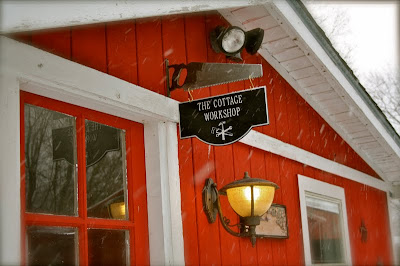I hope everyone had a wonderful Christmas. I had a great one this year blessed with lots of gifts, parties, family and food. Judging by the gifts I must have been a good boy this year.
I got two books. The Workshop by Scott Gibson is a very inspiring book full of pictures of woodworking shops and studios. The other book is the one which was probably on most hand-tool user's wish list -The Joiner and Cabinet Maker by Schwarz and Moskowitz as well as the original anonymous author.
The Joiner and the Cabinetmaker is a story about a young apprentice in a rural English woodworking shop in he early 1800's. Within this story he builds three different projects using the tools and techniques of his time, all of which is explained and detailed by Christopher Schwarz and Joel Moskowitz. The book includes a CD with narrated slide show by Schwarz (excellent from what I've been able to see so far) as well as SketchUp files of each project so that you can use Google SketchUp (a free downloadable application) to look at them in 3-D or take them apart as you wish. The readers are encouraged to build along with the instructions which is what I'm thinking about doing. I've still got my dresser project on my plate, but I may have to squeeze-in another.
The other workshop-related items I got as gifts were the two mini-sized offerings from Lee Valley tools. I came upon the pocket marking gauge and the miniature shoulder plane the day they were announced and just had to have them.
The pocket gauge is pretty cool. It has an adjustable marking head on both ends which gives you the ability to keep two different measurements set during a project. It's fairly easy to set one-handed and the cutting wheel will recess into the fence to keep it safe after use.
The Veritas miniature shoulder plane is just neat. It's really small but well made. I actually works pretty well but even if it didn't it would serve just fine as a conversation piece on a shelf, displayed as decoration or jewelry on a chain. I honed the blade and then used it to make a 1/4" dado in some scrap poplar. Not too bad...

I scored the width of the dado with a square and a marking knife, then clamped a straight-edge to one side to guide the shoulder plane. After every third pass or so I scored the sides again with the knife.

Ultimately, I'm not sure this would be used often but it's nice to know that it could be used. It came in a nice black case which is where I'll keep it until that time comes.
My favorite gift, of course, was the new sign for the Cottage Workshop. Here it is...
I hope you all had a merry Christmas and, if I don't blog until then,
HAVE A HAPPY NEW YEAR!
-RM
















































